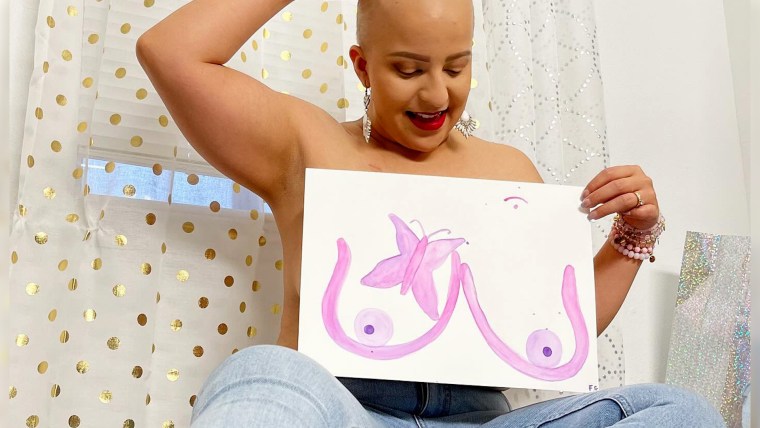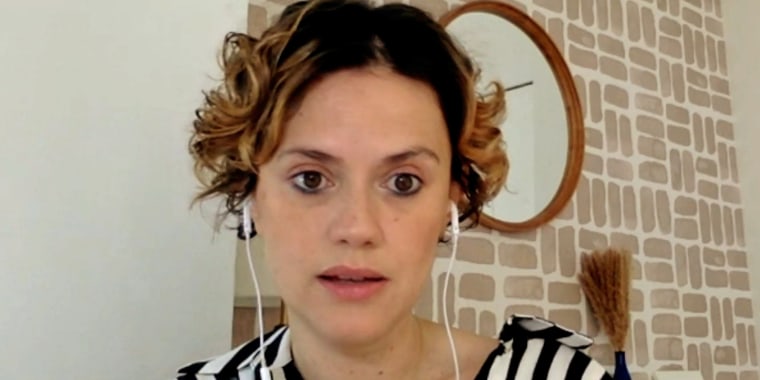Colombian American journalist Laura Hernández was 39 in January 2022 when she felt a small lump under her left armpit.
Worried, she quickly went to her gynecologist.
“She was much more relaxed than me. She told me, 'It’s nothing, but just in case, we’re going to send you a mammogram,'" Hernández said.
The mammogram didn't yield a definitive result because of the density of her breast tissue, but she was marked as suspicious. A subsequent biopsy confirmed Hernández' bad feeling — she had breast cancer.
"This is happening to all of us, it is happening to us when we're very young, and it's happening to Latinas," said Hernández, who lives in New York City with her husband and son. She underwent a lumpectomy and said her cancer was now in remission.
Though Hernández had a good outcome, each year about 42,000 women in the U.S. die from breast cancer. Though breast cancer is the second-leading cause of cancer deaths in U.S. women after lung cancer, it's the leading cause of death for Black and Latina women.
Though October was a month to raise awareness about the disease, there are still misconceptions about breast cancer: for example, that it only affects women — about 500 men die each year of the disease, according to the Centers for Disease Control and Prevention — or that it only affects women over the age of 40.
'Women know their bodies'
According to the American Cancer Society (ACS), the median age when woman are diagnosed with breast cancer is 62, and for Latinas it's slightly lower, at 57.
"A very small number of women diagnosed with breast cancer are younger than 45," according to the ACS.
But in 2022, 4% of invasive breast cancer cases and new ductal carcinoma in situ cases (an early form of breast cancer) were detected in women under 40, according to the ACS. Hernández was among those 12,080 women.
The ACS states that women should have the option of getting mammograms starting at age 40, and should get one once a year starting at 45.
Dr. Estelamari Rodríguez, a spokesperson for the ACS, recommends starting “much earlier” in case of a family history of breast or ovarian cancer. She also encourages women to examine their breasts regularly and to see a doctor if they detect anything abnormal.
If necessary, she said, “seek a second opinion, because women know their bodies and if they see a change, it must be recognized and addressed,” adds Rodríguez.
Julieta Cruz, who is Mexican American and lives in Sarasota, Florida, was 33 and finishing breastfeeding her baby when she detected “a little ball” in her breast.
According to Cruz, her doctor told her it was a hormonal lump or accumulated milk and insisted she shouldn't worry about it. But Cruz told Noticias Telemundo that her intuition and her experience as an assistant in a doctor’s office made her think something was wrong.
After insisting for three months, Cruz said, she managed to have a mammogram, but a specialist ruled that it was fibrosis or a cyst and that she would have to wait six months for another test. Additionally, a genetic test came back negative for cancer risk.

"'You’re very stressed, very anxious,'” Cruz said her co-workers told her. Cruz then let three weeks pass and pretended that she was in a lot of pain and went to another clinic to be examined. The ultrasound test “looked a little serious," she said, and the biopsy confirmed that she had stage 1 cancer (the first of five, with a 98% survival rate, according to the CDC).
The most common medical treatment options in these cases are to operate to remove the cancer (lumpectomy) or to remove part or all of the breast (mastectomy). The decision may involve medical or personal reasons for the patient, and the treatment is sometimes accompanied by chemotherapy, radiotherapy and hormonal treatments.
Cruz opted for a double mastectomy against the advice of her doctors, who recommended a lumpectomy. Cruz said she wanted to “eliminate the problem at its roots.” On her path to healing, she lost her breasts, as well as her hair, eyebrows and eyelashes because of the other treatments.
“Suddenly losing that and looking in the mirror and not recognizing yourself, it's hard, right?” Cruz said. "You have to start from within."
Two years later, at 36, Cruz' tumor is in remission. She has blood tests every six months and will have to take a pill daily for 10 years. But Cruz has fulfilled her dream of becoming a makeup and hair artist.
“Love yourself and say ‘Wow, I’m a warrior!’” Cruz said. “I’m worth much more than my breasts, more than my hair, more than my physique.”
An earlier version of this story was first published in Noticias Telemundo.
